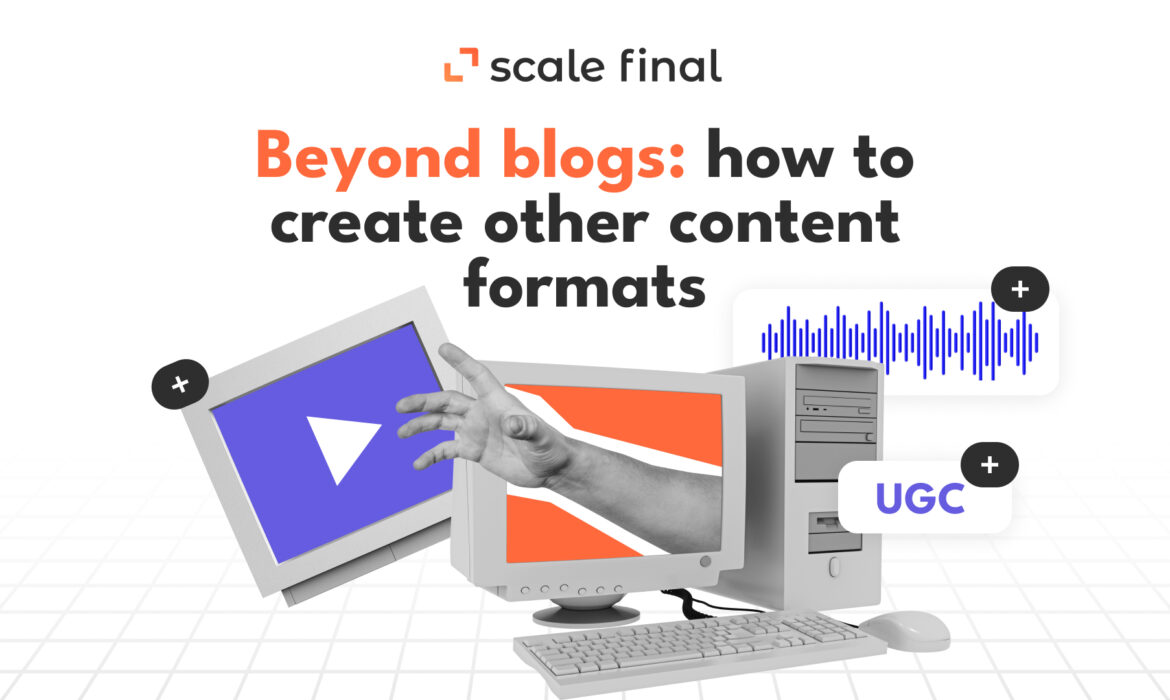Home • Blog • Beyond blogs: how to create other content formats
Beyond blogs: how to create other content formats
Content marketing is one of the most promising tools to make your company known online.
It is so promising because it helps:
- attract and engage an audience,
- build brand loyalty and trust,
- build expertise in your niche,
- generate traffic and conversions.
But for content marketing to work, you should first research your target audience. Consider their needs and current trends. Finding suitable content formats is the key, considering different purposes and communication channels.
In this article, we’ll introduce you to some content formats and show you how to create them effectively.
Video content
Video content is not new, but it is still a relevant and sought-after content format.
According to Cisco, video traffic will account for 82% of all Internet traffic by the end of 2023.

Advantages of the video content:
- it’s visual and dynamic, which attracts attention and increases engagement;
- it is informative and compelling, which increases trust and credibility;
- it is versatile and flexible, so it can be adapted for different purposes, audiences and platforms.
Types of video content you can use in marketing:
- educational videos;
- promotional and advertising videos;
- customer testimonials and case studies;
- interviews and expert opinions;
- live streams and webinars;
- stories and shorts;
- animations and infographics;
- entertaining videos.
To create quality video content, you need to:
- Identify the purpose, audience, and platform for each video;
- Create a script or outline of the video with key points;
- select the appropriate style, tone, and format for the video;
- provide good sound, lighting and background for the shoot;
- use professional equipment or high-quality applications for shooting and editing;
- add titles, descriptions, tags and thumbnails to optimize the video for search and viewing;
- distribute the video through various communication channels: website, social media, YouTube, email.
Audio content
Audio content is a relatively new but rapidly growing content format.
According to Insider Intelligence, the number of audio content users in the U.S. will reach 212 million by the end of 2023.

Advantages of the audio content:
- it is accessible and easy to consume, as it does not require visual attention or special equipment;
- it is emotional and personal, as it reflects the voice and mood of the author or speaker;
- it is in-depth, as it shows the topic in detail
Types of audio content you can use in marketing:
- podcasts – series of audio recordings on a particular topic or niche;
- audiobooks – recorded versions of print or e-books;
- audio articles – recorded versions of text articles or blogs;
- audio messages – short voice messages used to communicate with listeners or customers;
- clubhouses – applications for audio chats with experts or viewers.
To create high-quality audio content, you need to:
- Identify the purpose, audience, and platform for each audio;
- create a script or outline of the audio with key points;
- choose the right style, tone, and format for the audio file;
- ensure good audio that is free of noise and interference;
- use professional equipment or high-quality recording and editing programs;
- add titles, descriptions, tags, and graphics to optimize audio files for search and listening;
- distribute audio through various communication channels: website, social media, Spotify, Apple Podcasts, email.
Interactive content
Interactive content is a content format that requires active user participation.

Advantages of the interactive content:
- it is captivating because it arouses interest and curiosity;
- it is personalized and targeted because it adapts to the user’s reactions and behavior;
- it is valuable and useful because it provides feedback and recommendations;
- it is converting, because it collects user data and contacts.
Types of interactive content you can use in marketing:
- quizzes and tests – short surveys with questions and answer options that provide the user with a result or score;
- calculators and simulators – tools for calculating cost, time, effectiveness, or other parameters;
- surveys and polls – forms to collect user opinions or preferences on various topics;
- infographics and maps – visual elements for presenting statistics, facts, or processes;
- games and puzzles – entertaining tasks that test users’ knowledge, logic, or reaction.
To create quality interactive content, you need to:
- determine the purpose, audience, and platform for each interactive content;
- create a script or outline of the interactive content with key points;
- select an appropriate style, tone and format for the interactive content;
- use professional services or applications to create and publish interactive content;
- add titles, descriptions, tags, and thumbnails to optimize interactive content for search and browsing;
- distribute interactive content through various communication channels: website, social networks, email.
If this is your gem, you can easily create interactive content with our quiz marketing guide: Quiz your way to success: boost conversions with quiz marketing
User-generated content
User-generated content is a content format that brand users create.

Advantages of the user-generated content:
- it is authentic and convincing because it shows real user experiences and testimonials;
- it is original because it reflects different user perspectives and styles;
- it is cost-effective and efficient because it is not expensive to create and distribute;
- it is engaging because it motivates users to share their opinions and participate in the community.
Types of user-generated content you can use in marketing:
- testimonials and reviews – text or video testimonials about a brand’s product or service;
- photos and videos – visuals of a brand’s product or service;
- articles and blogs – textual content with user experiences or tips about a brand’s product or service;
- social posts – postings on social media with a mention or hashtag of the brand;
- Contests and challenges – tasks or calls to action for users with the possibility of winning a prize or being recognized.
To create quality user-generated content, you need to:
- determine the purpose, audience, and platform for each piece of user-generated content;
- create a strategy and plan for promoting and collecting user-generated content;
- provide users with clear guidelines, criteria, and rules for creating user-generated content;
- moderate and select high-quality and relevant user-generated content;
- add titles, descriptions, tags, and thumbnails to optimize user-generated content for search and browsing;
- distribute user-generated content across multiple communication channels: website, social media, and email.
Here you’ll also find some tips on how to encourage UGC: User-Generated Content (UGC) and its impact on your business
Conclusion
For content marketing to be effective, choosing the format is critical. Videos grab attention, audio provides intimacy, interactive content ensures engagement, and user-generated content brings authenticity. You need to ask yourself who you are and evaluate your business.
Maybe there’s a gap you can cover with the content marketing format.
Use each of these content format strengths to connect with your audience in a meaningful way.
Author
-
 ScaleFinal Content Writer
ScaleFinal Content WriterExperienced writer in different domains. I package meaning into words and bring people together. Know how to convey the vision and values of a product in writing. I like reading, movies, sports and blockchain.
View all posts






